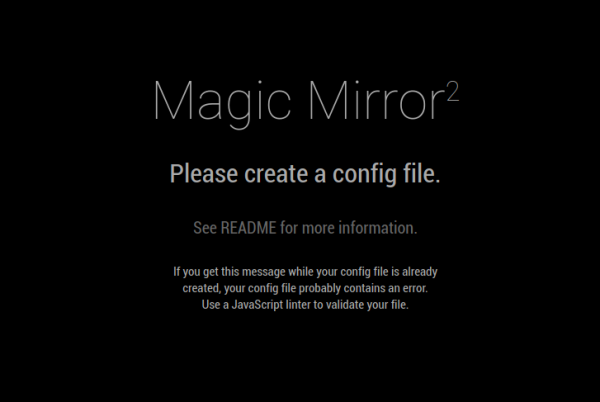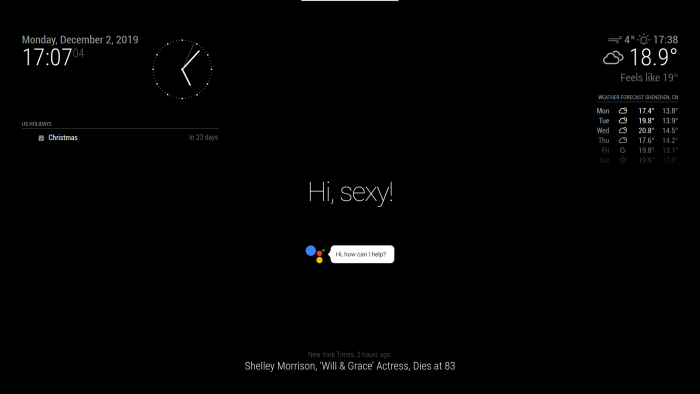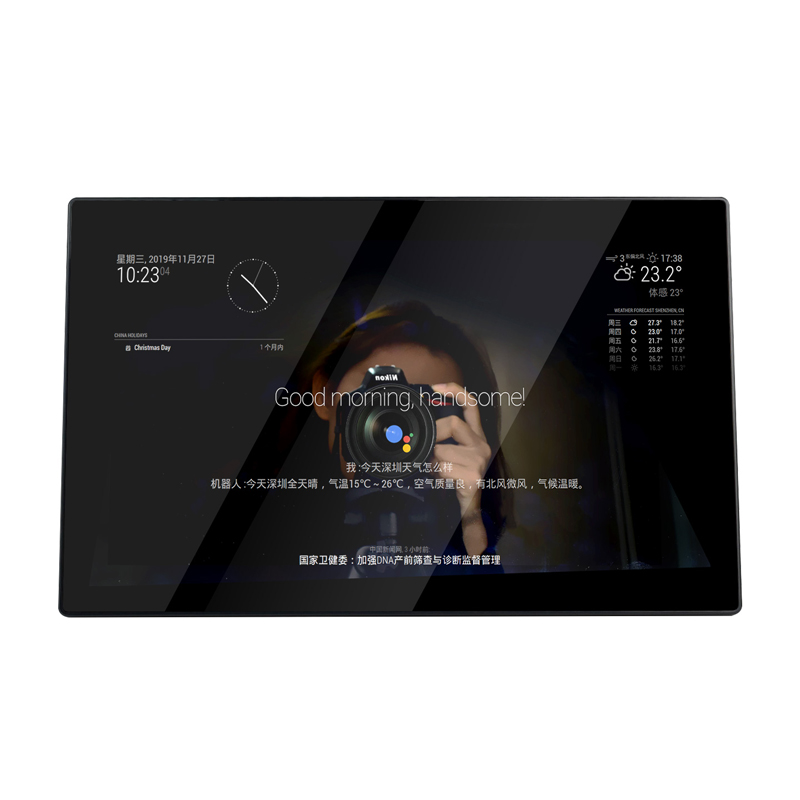- sales/support
Google Chat: zj734465502@gmail.com
- sales
+86-0755-88291180
- sales01
sales@spotpear.com
- sales02
dragon_manager@163.com
- support
tech-support@spotpear.com
- CEO-Complaints
zhoujie@spotpear.com
- sales/support
WhatsApp:13246739196
- HOME
- >
- ARTICLES
- >
- Common Moudle
- >
- LCD
13.3inch Magic Mirror User Guide
Introduction
13.3inch Magic Mirror, Voice Assistant, Touch Control, Raspberry Pi 3A+ Inside
Features
- 13.3inch IPS screen,1920x1080 high resolution
- Embed Raspberry Pi 3A+ as controller
- One-way mirror, can display news, weather and time.
- Toughened glass capacitive touch panel, 6H hardness, supports up to 10-points touch
- Embedded ferrite Hi-Fi speaker
- Embedded Microphone And Speaker, Adopts Snowboy Hotword Detection Engine
- 75x75mm spacing mounting holes (M4 screw hole) for general wall mount
- Comes with 75° tilt angle stand
User Guide
To use the Magic mirror, you can use the pre-configured image which we provide or configure it yourself with the original Raspbian image.
Method 1. Pre-configured image
- 1. Download the pre-configured image and write it to your SD card
- 2. Add the following lines to wpa_supplicat.conf files in the BOOT directory. (if you didn't find the files, create it)
ctrl_interface=DIR=/var/run/wpa_supplicant GROUP=netdev
update_config=1
country=US
network={
ssid="your_real_wifi_ssid"
psk="your_real_password"
}
Note: you need to change your_real_wifi_ssid and your_real_password" to the real ssid and password
- 3. Inset the card to Raspberry Pi and power on it
Method 2. Configure image manually
- 1. Write Raspbian image
- Download the lasted Raspbian image from the Rasberry Pi website and write it to an empty micro SD card.
- Create a new txt file under the BOOT directory of micro SD card and name it as SSH.
- Modify config.txt file which is located at BOOT directory, add the following lines to config.txt file
hdmi_group=2 hdmi_mode=82 hdmi_cvt 1920 1080 60 6 0 0 0
- Save and insert the micro SD card to Raspberry Pi.
- Connect the Magic mirror to network and power on Raspberry Pi.
- After booting, you can access Raspberry Pi via SSH, or directly connect keyboard and mouse.
- 2. Install WM8960 sound card driver
- Open the terminal and use the following commands to install
git clone https://github.com/waveshare/WM8960-Audio-HAT cd WM8960-Audio-HAT sudo ./install.sh
- Modify config.txt file, remove the following line from the file or comment it.
#dtparam=audio=on
- Then reboot Raspberry Pi
sudo reboot
- After rebooting, check the driver by the following command
sudo dkms status
- If you can get the information as below, it means that the driver was installed successfully.
wm8960-soundcard, 1.0, 4.19.58-v7l+, armv7l: installed
- Test the sound card
- Test playing: aplay -l
pi@raspberrypi:~ $ aplay -l **** List of PLAYBACK Hardware Devices **** card 0: wm8960soundcard [wm8960-soundcard], device 0: bcm2835-i2s-wm8960-hifi wm8960-hifi-0 [] Subdevices: 1/1 Subdevice #0: subdevice #0
- Test recording: arecord -l
pi@raspberrypi:~ $ arecord -l **** List of CAPTURE Hardware Devices **** card 0: wm8960soundcard [wm8960-soundcard], device 0: bcm2835-i2s-wm8960-hifi wm8960-hifi-0 [] Subdevices: 1/1 Subdevice #0: subdevice #0
- 3. Install Magic Mirror driver
- Open terminal and type the following commands
curl -sL https://deb.nodesource.com/setup_10.x | sudo -E bash - sudo apt install -y nodejs git clone https://github.com/MichMich/MagicMirror cd MagicMirror/ npm install
- After installing, run the command to display
DISPLAY=:0 npm start
cd ~/MagicMirror/modules git clone https://github.com/waveshare/MMM-VoiceAssistant.git cd MMM-VoiceAssistant cp config/config.js.en ~/MagicMirror/config/config.js #显示英文 #cp config/config.js.cn ~/MagicMirror/config/config.js #显示中文 cd ~/MagicMirror DISPLAY=:0 npm star
sudo apt-get update sudo apt-get install python3-dev python3-venv python3 -m venv env env/bin/python -m pip install --upgrade pip setuptools wheel source env/bin/activate
- Note: The following steps should be take in the virtual environment, if you close the terminal and restart it, you should use the command below to enter the environment again firstly
source ~/env/bin/activate
- 5. Install snowboy
- Install libraries
sudo apt-get install swig sudo apt-get install libatlas-base-dev sudo apt-get install portaudio19-dev sudo apt-get install flac pip3 install PyAudio pip3 install SpeechRecognition
- Download snowboy
git clone https://github.com/Kitt-AI/snowboy.git cd snowboy/swig/Python3 make cd ../../examples/Python3
- Modify snowbiydecoder.py file. Change from.import snowboydetect to import snowboydetect. Save and enable snowboy
cd ~/snowboy/examples/Python3 python3 demo.py resources/models/smart_mirror.umdl
- Try to say smart mirror, you will hear ding and the information below are printed on the mirror
INFO:snowboy:Keyword 1 detected at time: 2019-12-03 11:30:16
- 6. Install Google Assistant Service
- Create .asoundrc file in /home/pi directory (the user directory)
nano .asoundrc
- Add the following lines to the .asoundrc file
pcm.!default {
type asym
capture.pcm "mic"
playback.pcm "speaker"
}
pcm.mic {
type plug
slave {
pcm "hw:0,0"
}
}
pcm.speaker {
type plug
slave {
pcm "hw:0,0"
}
}
- Accoding to the official guide to install Google Assistant Service
- Please follow the third step of the official guide to configure and create OAuth Client ID JSON file. Don't forget to copy the JSON file to your Raspberry Pi.
- Following the fourth step of the guide to register device model
- Install Google Assistant SDK
(env) $ sudo apt-get install portaudio19-dev libffi-dev libssl-dev (env) $ python -m pip install --upgrade google-assistant-sdk[samples]
- Authorize model
(env) $ python -m pip install --upgrade google-auth-oauthlib[tool]
- Genegrate credential
(env) $ google-oauthlib-tool --scope https://www.googleapis.com/auth/assistant-sdk-prototype \
--save --headless --client-secrets /path/to/client_secret_ client-id .json
- Then you will get an URL, please copy it and open it on browser of your PC.
Please visit this URL to authorize this application: https://...
- Go to the URL, you are asked to log in your Google Account and get the authorization code by following guides, Copy the code to the terminal
Please go to this URL: https://... Enter the authorization code:
- If the authorization process is done successfully, you will get the information as below.
credentials saved: /path/to/.config/google-oauthlib-tool/credentials.json
- Use the following commandto test.
googlesamples-assistant-pushtotalk --project-id my-dev-project --device-model-id my-model
- Note: my-dev-project is the Google Could Platform ID of Actions Console porject you created. You need to find the project ID in Actions Console. my-model is the device model name you create
- Press Enter, and try to ask something.
- 7. Set auto-run
- Install PM2
sudo npm install -g pm2
- Setup pm2
pm2 startup
- You will get informatin below, please copy the command and run it on terminal
[PM2] To setup the Startup Script, copy/paste the following command: sudo env PATH=$PATH:/usr/bin /usr/lib/node_modules/pm2/bin/pm2 startup systemd -u pi --hp /home/pi
- Run Magic mirror by PM2
cd MagicMirror/modules/MMM-VoiceAssistant/pi pm2 start mm.sh
- Run snowbiy by PM2
cd MagicMirror/modules/MMM-VoiceAssistant/pi pm2 start snowboy.sh
- Set auto-run
pm2 save
- If you want to disable the sevices, you can aslo use the following command
pm2 stop mm pm2 stop snowboy
- 8. kepp display lighting all the time
- Modify lightdm.conf
sudo nano /etc/lightdm/lightdm.conf
- Find the line "Xserver-command" below [SeatDefaults] section and change it from
#xserver-command=X
to
xserver-command=X -s 0 -dpms
- Then save and reboot
sudo reboot
TAG:
ESP32 C3
Changeable Photo Frames
Raspberry Pi 8 inch DSI LCD Display With 5MP Front Camera MIPI 800×480 Capacitive TouchScreen
Milk V Duo UART
7.5 inch Passive NFC e-Paper V2 BW Display 7.5inch E-ink Screen No Need Battery Wireless Powered Data Transfer For Mobile APP
Sipeed NanoCluster Mini Cluster Board mini data center For Raspberry Pi CM45 / Computer /LM3H /M4N
ESP32-C3FN4
Raspberry Pi DSI LCD
USB TO RS485
RS485 Interface
LuckFox Pico
Raspberry-Pi-Game-1.54inch-LCD-touchscreen-display-ST7789
USB TO 2.5G Ethernet Port Converter RJ45 RTL8156B Driver-Free For Windows/macOS/Linux/Android
Supports 6V~24V Solar Panel
Luckfox Pico PLUS
Milk-V Duo Camera Tutorial
Allwinner H618
ESP32-S3 Round LCD
Raspberry Pi 5 ABS Case
14 inch Dual LCD Computer PC Monitor Display Double Secondary Screen Type C Mini HDMI 1080P For Windows/MacOS
TAG:
RDK X5 Acrylic Case Black chassis heat dissipation holes
ESP32-H2 Microcontroller Development Board
Milk-V Duo Agency
X872 Raspberry Pi 4 USB M.2 NVMe SSD NAS
Raspberry Pi 18.5inchFHD LCD 1920x1080 Capacitive TouchScreen Display
RS485 to RJ45
ESP32-S3 1.28inch Round LCD Display TouchScreen Accelerometer Gyroscope Sensor Case
Milk-V Duo Ethernet
Jetson 64MP Camera
RS485 SeeedStudio-XIAO
Providing Effective Interference Shielding
4.26inch E-link
Raspberry Pi 5
11.6 inch LCD In-Cell Type C HDMI Capacitive Touchscreen Display Raspberry Pi Jetson Nano mini PC 1768x828
spotpear
Raspberry Pi 5 PCIe M.2 5G 4G 3G RM530N-GL
Spotpear Project Customization Raspberry Pi / Arduino / ESP32 / Jeston Nano Related project customization
Milk V Duo
Raspberry Pi IR Array Thermal Imaging Camera Far infrared 80×62 Pixels 45/90 Degree FOV
Raspberry Pi 5 ICE Tower Argon THRML 60mm Radiator Cooler CPU Cooler Copper Tube Fins








